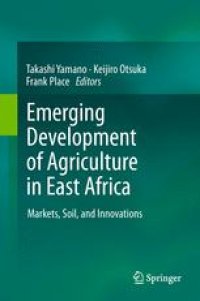
Ebook: Emerging Development of Agriculture in East Africa: Markets, Soil, and Innovations
Author: Takashi Yamano Keijiro Otsuka Frank Place (auth.) Takashi Yamano Keijiro Otsuka Frank Place (eds.)
- Tags: Agricultural Economics, Development Economics, Economic Policy, Soil Science & Conservation, Sustainable Development
- Year: 2011
- Publisher: Springer Netherlands
- Edition: 1
- Language: English
- pdf
Based on a coordinated panel study of more than 2,400 households in three countries—Kenya, Uganda, and Ethiopia—this book provides unprecedented insight into how agricultural productivity can be improved. Its vast coverage of over 240 different communities offers a wide variety of policy, market and agro-climatic contexts, thus enabling more certain conclusions to be drawn about which strategies are more probably universal or context-specific.
Emerging Development of Agriculture in East Africa offers case studies that find promise in many new innovations. Farmers in Uganda have quickly learned the management of NERICA rice (a new upland rice variety), which is being disseminated in a limited way in the region. Also in Uganda, farmers living in more remote areas have improved access to markets due to the expansion of mobile phones. In Kenya, improved milk marketing systems have increased efficiency and led to tangible increases in the adoption of dairy production technologies. And the adoption of intensive dairy production systems in Kenya and Uganda are providing significant amounts of manure and positively impacting yields of maize and banana.
Despite the success of these innovations, many of their impacts are limited in terms of depth (size of impact per household) and breadth (number of households). Therefore, each chapter details key constraints to improved impact and the potential policy strategies to overcome them. Many recommendations concern the improvement of markets, which is imperative to increasing agricultural productivity and reducing poverty. Particular emphasis is placed on the role of technology to induce institutional and market change, as was evident in Asia’s Green Revolution. Altogether, the studies in the book suggest that, in addition to improving markets and the output / input price ratio, it is essential to improve technology (e.g. varieties or water management) so that fertilizer and other inputs can earn a higher return.